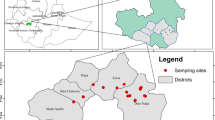Abstract
Lakes are important water resources. Unfortunately, natural factors and human activities, have resulted in declining water quality and eutrophication. These changes directly affect lake ecological environments and the ability for people to live off of the affected water. Satellite remote sensing data is important because it can quickly provide comprehensive, real-time, dynamic water quality information; it must supplement conventional water quality monitoring techniques. In this study, water from the Poyang Lake entryway and surface was collected from April to December in 2009 and analyzed via MODIS remote sensing data. The data and a comprehensive scoring method was used to establish surface water transparency, total phosphorus inversion model, and nutritional status. The results showed that eutrophication averaged at 59.8.; however, the nutritional status varies greatly in the wet season, normal season, and dry season. The nutritional status is highest in dry season, followed by normal season, and lowest in wet season. Moreover, the eutrophication degree increases gradually year by year.


Similar content being viewed by others
References
Cai, Q. H. (1993). Evaluation on Eutrophication of Wuhan East Lake. Oceanologia Et Limnologia Sinica, 24(4), 335–339.
Cai, Q. H. (1997). Comprehensive Evaluation of Lake Eutrophication. Journal of Lake Sciences, 9(1), 89–93.
Ge, D. B. (2005). Chlorophyll_a and its Relationship with Water Quality in South Lake, Yueyang City. Environmental Monitoring in China, 21(4), 69–71.
Hu, M. L. (2009). Characteristics of water level, water environment and effects on fish communication and migration in the hukou area of Poyang lake. Doctoral dissertation.
Hu, R., Lin, Q. Q., & Duan, S. S. (2002). Distribution of Chlorophyll-a and Phosphorus in Subtropical Reservoirs. South China. Ecologic Science, 21(4), 310–3150.
Jiang, H. (2012). Research on Transparency Derived from Remote Sensing and Its Spatial-Temporal Changes in Poyang Lake. China Rural Water and Hydropower, 1, 30–33.
Lau, S. S. S., & Lane, S. N. (2002). Biological and Chemical Factors Influencing Shallow Lake Eutrophication: A Long-Term Study. Science of the Total Environment, 228, 167–181.
Liu, Y., & Jiang, H. (2013). Retrieval of Total Phosphorus Concentration in the Surface Waters of Poyang Lake Based on Remote Sensing and Analysis of Its Spatial-Temporal Characteristics. Journal of Natural Resources, 28(12), 2169–2177.
Ma, R., Tang, J., Duan, H., Pan, D. (2009). “Progress in Lake Water Color Remote Sensing”. Journal of Lake Sciences, 21(2), 143–158.
Quan, W. M., Yan, L. J., Yu, Z. M., & Jiao, L. (2001). Advance in Study of Lake Eutrophication Models. Biodiversity Science, 9(2), 168–175.
Ruan, X. H. (2008). Correlation Between Chlorophyll-a Concentration and Environmental Factors in Shallow Lakes in Plain River Network Areas of Suzhou. Lake Sciences, 20(5), 556–562.
Seitzinger, S. P. (1988). Denitrification in Freshwater and Coastal Marine Ecosystems: Ecological and Geochemical Significance. Limnology and Oceanography, 33(4), 702–724.
Wang, M. C., Liu, X. Q., & Zhang, J. H. (2002). Evaluate Method and Classification Standard on Lake Eutrophication. Environmental Monitoring in China, 10, 47–49.
Wu, G. F., & Cui, L. J. (2008). Remote Sense-Based Analysis of Sand Dredging Impact on Water Clarity in Poyang Lake. Acta Ecologica Sinica, 28(2), 6113–6120.
Acknowledgments
The authors appreciate the support from the National Natural Science Foundation of China (No.41461080), Nanchang Institute of Technology youth fund - Natural science project (2014KJ006), Nanchang University “Poyang Lake Environment and resource utilization Key Laboratory of the Ministry of Education” Open Fund (13005873). Special thanks are given to the anonymous reviewers and editors for their constructive comments.
Author information
Authors and Affiliations
Corresponding author
About this article
Cite this article
Hui, J., Yao, L. Analysis and Inversion of the Nutritional Status of China’s Poyang Lake Using MODIS Data. J Indian Soc Remote Sens 44, 837–842 (2016). https://doi.org/10.1007/s12524-015-0519-4
Received:
Accepted:
Published:
Issue Date:
DOI: https://doi.org/10.1007/s12524-015-0519-4




